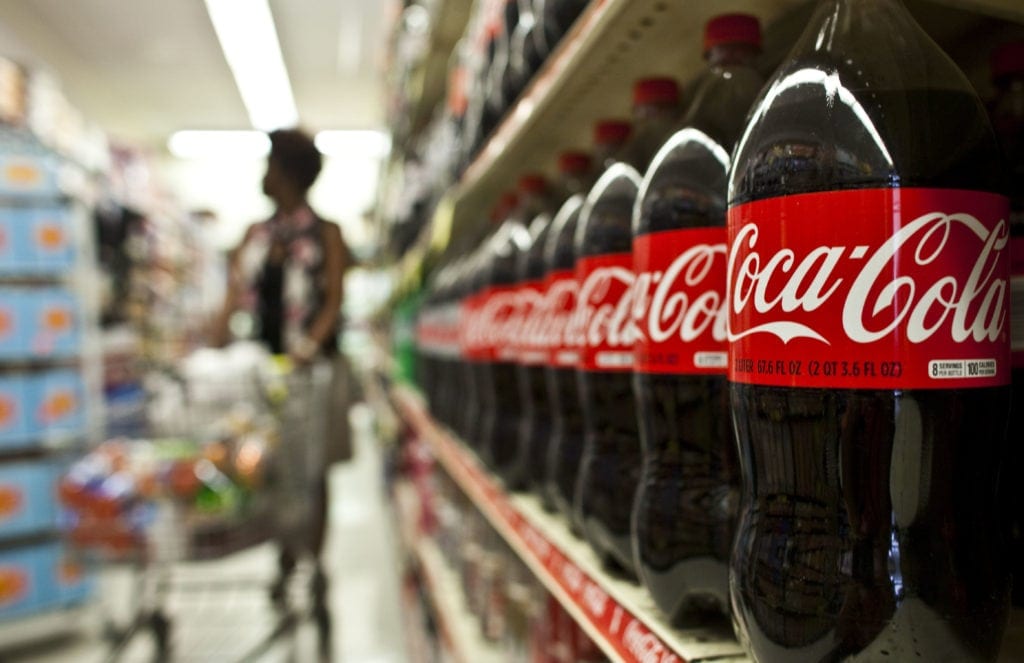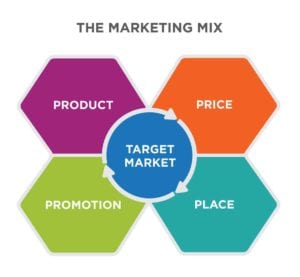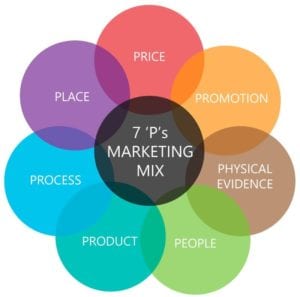On paper, marketing may not sound like a lot of work. After all, it’s only about promoting and selling products and services, isn’t it?
What people don’t realize is that there’s a significant amount of research and planning involved in executing every marketing campaign. This is probably why experts can’t help but pay attention to every tiny little detail in this strenuous process. How here’s where a marketing mix comes into the equation.
Using a marketing mix helps chuck out extra details, allowing marketers to design the most effective strategy for their products and service. In this elaborate guide, we will be discussing about marketing mix in detail and how you can develop one of your own.
Table of Contents
What is a Marketing Mix?
A marketing mix comprises of a bunch of tools, tactics or actions that a company might use to introduce and promote its product or brand. The 4 Ps of marketing is made up of:
- Price
- Product
- Promotion
- Place
However, because of the increasing demands of the field, there’s been an introduction of 7 Ps of marketing which also includes components such as people, positioning, and packaging.
Importance of Marketing Mix
Each component found in a marketing mix greatly influences the business plan of the company, ensuring its success. It basically highlights important pointers for marketers and key stakeholders that’ll come in handy throughout the lifecycle of the product.
The mix will play a crucial role in identifying the best marketing strategy for your business. It’s also a primary step to creating your marketing or business plan. This is why a lot of effort, research, and planning goes into formulating a marketing mix. In fact, a number of people are consulted throughout the process to ensure no major or minor details are left out.
What Are the 4 P’s Of Marketing
While marketing mixes are becoming more elaborate and detailed, it’s a good idea to start off with the basic 4 Ps. Here goes:
Product
The product refers to a tangible item or service that you’re trying to sell. In order for it to have any value at all, it must fulfill some kind of need for the consumer. The product must offer excellent performance or else even the best marketing strategy won’t be able to save it from plummet.
For this, marketers must sit down and plan out various stages of the product cycle according to their particular needs and requirements. The first step in this cycle is identifying what problems the product can solve. For this, all professionals on the team must fully understand the features and USP (unique selling proposition) of what they’re offering. Once the true potential of the product is identified, marketers can move on to the next step which is deciding the price of the product.
Price
You can’t market a product without putting a price tag on it! This can only be done once marketing professionals have developed a concrete understanding of the product. The price of the product plays a crucial role in determining how the product will sell in the market.
It’s important to note that consumers calculate a perceived value of a product in their minds before they’ve even seen the price tag. Problems will arise if there are fluctuations in the price and it does not align with the consumer’s perceived value. For instance, imagine you’re shopping for a new pair of running shoes that look great at a first glance. However, on close inspection, you notice that the quality of the material is below par which is quite surprising because the shoes are insanely expensive.
At this point, the consumer may start to grow skeptic about your brand. Marketers thus need to find a way to see products from the eyes of consumers. So if the product doesn’t offer much, it will hold little value for the consumer.
Additionally, the price will also depend on value chain costs and other factors including how competitors have priced similar products.
Promotion
Once you’ve got yourself a final product and have decided a price, the next step is promotion. After all, you can’t sell a product unless consumers already know about it, can you?
This part includes many different aspects such as sales promotions, social media marketing, email marketing, advertising and much more. The appropriate channel(s) will be decided by marketers according to the nature of the product. Additionally, the channel must be aligned with the interest of consumers, for instance, if you’re promoting a new energy drink for youngsters, you’re likely to reach your target audience more effectively using social media. This is primarily because teenagers and young adults spend a lot of time on platforms such as Facebook and Instagram.
As a marketer, you can also come up with interesting contests and prizes ahead of your product launch to generate hype and get customers excited.
Place
Proper placement is key to marketing any product successfully as it’ll drastically impact distribution. Marketers must thus put their heads together to determine ideal locations that’ll attract as many prospective customers as possible. Today, thanks to the social media frenzy, most consumers are more or less converted or engaged online.
However, if you own a physical store, you’ll have to ensure it’s based somewhere consumers will be able to find it easily. On the other hand, if you’re an online retailer, opt for an identifiable web domain and an easy to navigate website.
Marketing professionals can choose from a number of potential locations as part of their placement strategy. This, of course, will depend on the nature of the product and where its target audience hangs out.
Extended Marketing Mix Modeling
The traditional 4 ps of marketing gained popularity for many years until it finally considered too simplistic. Experts began to think that the original model lacked depth and offered room for improvement
5 Ps of Marketing
For better clarity, Judd added the fifth p in the existing marketing model to highlight the contribution of people. This p pays tribute to the people behind all the action, specifically those who are working hard to offer products and services to their consumers. These people play an integral role in shaping user experience and help make your marketing campaign. The second aspect of this component is your customers. Without them, there would virtually be no point of a marketing campaign which is why each campaign is tailored around, well – people.
People
The basis of adding an extra p was to highlight the importance of people that are communicating messages to the audience. Here, professionals must take customer services and staffing into account. This is primarily done via training sessions and other exercises.
7 Ps of Marketing
In 1981, the original model was further extended to add three more elements, resulting in the 7 p’s of marketing. The revised Booms & Bitner model was designed to highlight the importance of services in addition to tangible, physical elements. The additional three elements included people, processes, and physical evidence.
Processes
Processes refer to how you plan to distribute and deliver your products and services to consumers. In the long run, consumers are also paying for how the service is delivered to them. Think of ways to improve your services and provide utmost convenience to your consumers.
Physical Evidence
The final p stands for physical evidence and refers to all the physical components that consumers will be interacting with your business. For instance, this could include the packaging of the product, branding, layout and of course, the overall environment of the place where you’re selling your products and services. All these elements will ultimately contribute to the user experience.
How to Craft a Marketing Mix
The marketing management is often responsible for developing a marketing mix. However, extensive research is crucial to ensure that all key points are based on facts and not assumptions. Follow these steps to develop a marketing mix:
Define Your Unique Selling Proposition
The most primary step to devising a marketing mix is to define a unique selling proposition. Think about it. Here are some questions you ought to ask yourself:
- Why would consumers be interested in your product?
- What are your product’s biggest
- What do you have to offer that your competitors don’t?
Use focus groups and customer surveys to determine how important your USP is. Your potential customers should clearly be able to highlight the key benefits and features of the product in order for the product to sell. Be willing to go above and beyond with research if you want your product to stand out, all these pointers must be showcased in your marketing campaign.
Find Your Target Audience
Take inspiration by writing down a few sentences about your target audience or create a buyer’s persona. This will act as an indispensable tool for marketers who really want to hit the spot and assess each marketing tactic with great attention. For extra measure, you must base customer profile one aspects such as gender, age, demographics etc.
On the other hand, if you’re targeting other businesses, consider factors including the company’s size and location.
Assess the Competition
There are probably dozens or maybe even several thousands of businesses that are offering something similar to your product. So what do you do? You evaluate your competition.
Try to figure out their strategy and understand what keeps them going. Some businesses offer special discounts and warranties to spike up sales and get the attention of consumers. Determining the subject worth of the product and then eliminating its additional costs will help you decide on a reasonable price point. This will especially come in handy when you are devising pricing strategy.
Create a Pricing Strategy
Once you have examined the value of similar products in the market, use your marketing research to develop an appropriate pricing strategy. This will help make sure you do not overprice or underprice the product.
Shortlist Placement Options
At this stage (once you’ve developed a pricing strategy), you must move forward with assessing placement options. Evaluate where your prospective customers are most likely to hang out and make a purchase. You must also consider any costs that may be associated with that particular channel. For instance, if you’re thinking of opening up a physical store as opposed to an online one, you must keep additional expenses in mind.
Alternatively, you can also target multiple channels at the same time to attract a wide customer base. However, if you would like to target a particular niche, you may want to stick to specific channel or area that will benefit your company the most. It’s also worth keeping in mind that the availability of the product may directly impact its perceived value.
Devise a Promotion Strategy
How do you plan on getting the word out? In this phase, you must incorporate everything that you’ve learned about your target audience and use it to devise a commination strategy. Keep in mind that the promotion strategy that you opt for but be aligned with the needs and requirements of your consumers. The products must be promoted in a way that its benefits, features and USP is clearly understood by the audience.
If your company is on a tight budget, opt for a few affordable yet effective tactics that will help you reach your core audience. Once your campaign starts to get noticed, you can move on and target an even bigger number. Your tactics could include platforms such as social networking sites or direct mail to reach out to customers.
Marketing Mix of Coca-Cola

The Coca-Cola Company is undisputedly the most renowned and perhaps the most loved beverage company in the world. Over the years, the brand has successfully launched a number of new products, bringing down its final total to over 3300. Let’s take a closer look at its marketing mix for better understanding:
Product
The renowned beverage company has an incredibly large product mix that includes about 400 brands. Apart from regular soda, they also offer a variety of juices, sports drinks along with teas and coffees. Among the most popular is its flagship Coca-Cola which has been crowned the most popular selling soft drink to ever exist. Other notable brands include Sprite, Fanta, Minute Maid, Powerade, and Fresca.
At present, the company is focusing on introducing healthier drinks as people are slowly moving towards sugar-free options. The Coca-Cola Company first became a part of this trend when it introduced its first non-carbonated drink, Minute Maid in 1990s.
Price
Coca-Cola follows a comprehensive pricing strategy that is based on the perceived value of its products. Since Pepsi Co is the prime competitor and arch-rival of the brand, Coca-Cola ensures its pricing is within consumer reach. Overall, Coca-Cola’s pricing approach is closely aligned with maintaining brand loyalty.
Since its products are sold by a number of retail stores and distributors, each entity implements its own pricing strategy. While most drug-stores and gas stations sell its products at a fixed price, retail outlets may adopt a different strategy altogether.
Promotion
Coca-Cola is known as the most popular beverage company in the world and rightly so. To stay relevant, the company has employed a number of marketing and advertising strategies. It advertises its products using numerous communication channels including social media, direct mail, the World Wide Web along with traditional means of advertising such as billboards and TV commercials. Due to increased competition, Coca-Cola reportedly spent about $3.96. Billion on advertising last year.
One of Coca-Cola’s most successful campaigns was for Coke Zero in 2015. The drinkable advertisement was targeted at millennials, giving them a chance to sample the drink. According to the brand over 85 % of millennials had not tried the drink yet so this campaign was designed to introduce their product to a whole new audience.
In 2016, Coca-Cola announced a shift in is marketing strategy with its new “Taste the Feeling” campaign. The company emphasized on a “one brand” approach which was quite unique from its previous strategies.
Place
Coca-Cola has an enviable distribution system as its products can be found in over 200 countries all over the world. It is reported that the company is able to sell about 1.9 billion servings every day on an average which is a whopping number!
Coca-Cola follows an FMCG distribution pattern which has allowed the brand to penetrate all relevant players in the market. It is also worth mentioning that the brands bottling partners closely interact with consumers in amusement parks, convenient stores, street vendors etc. Together, all these partners have managed to create a successful localized strategy for Coca-Cola.
Wrapping it Up: Marketing Mix
We hope this elaborate guide has helped you learn more about marketing mix. Is there something you’d like to add? Tell us about it in the comment section below.
Image Credits: Blog.Scoop.it, Celebrista, Marketing91



